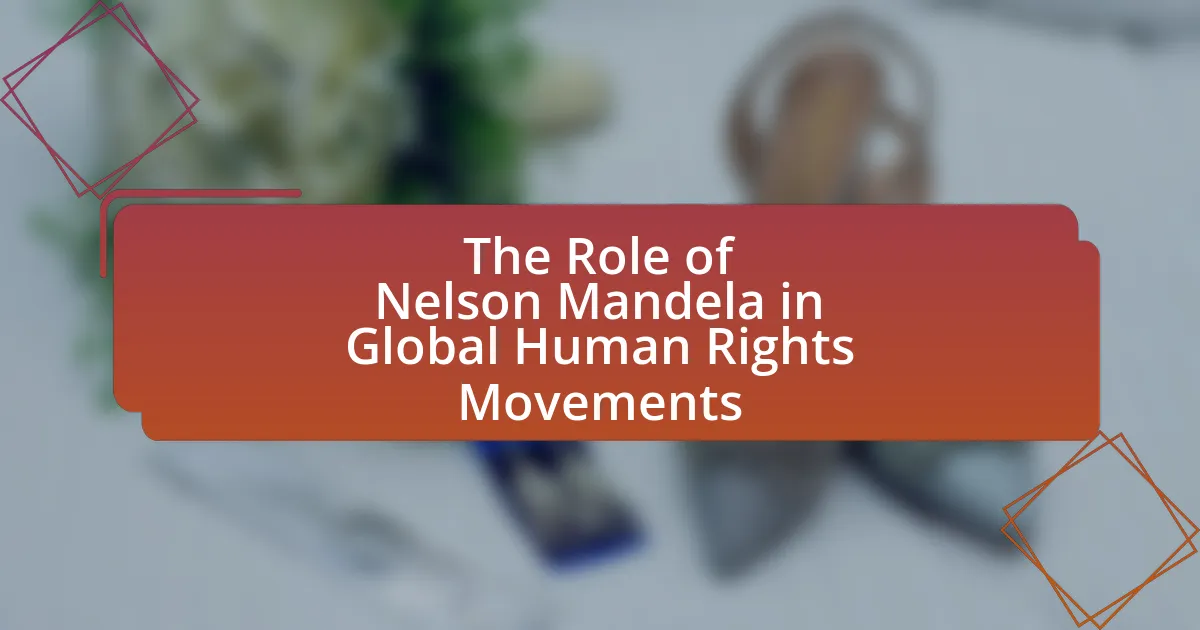Nelson Mandela’s leadership style, which evolved from a militant approach during the anti-apartheid struggle to a focus on reconciliation and inclusivity, serves as a significant influence for today’s activists. Key experiences, including his time in prison and early activism, shaped his principles of empathy, resilience, and moral integrity. Mandela’s strategies for uniting diverse groups against apartheid, such as promoting dialogue and collaboration, are relevant in contemporary social movements. His legacy continues to inspire modern leaders and activists, emphasizing the importance of reconciliation and inclusivity in achieving social justice and addressing systemic oppression.
How did Nelson Mandela’s leadership style evolve over time?
Nelson Mandela’s leadership style evolved from a militant approach to a more conciliatory and inclusive strategy. Initially, during the anti-apartheid struggle, Mandela adopted a confrontational stance, advocating for armed resistance through the African National Congress’s military wing, Umkhonto we Sizwe, which he co-founded in 1961. This phase was characterized by a focus on direct action against the oppressive regime, reflecting his belief in the necessity of armed struggle for liberation.
After his release from prison in 1990, Mandela’s leadership transformed significantly as he recognized the importance of negotiation and reconciliation. He prioritized dialogue over conflict, aiming to unite a deeply divided nation. His presidency from 1994 to 1999 exemplified this shift, as he worked to dismantle apartheid laws and foster national healing through initiatives like the Truth and Reconciliation Commission. This approach not only helped to stabilize South Africa but also set a precedent for conflict resolution globally, demonstrating the effectiveness of empathy and collaboration in leadership.
What key experiences shaped Mandela’s leadership approach?
Nelson Mandela’s leadership approach was shaped significantly by his experiences in the African National Congress (ANC), his imprisonment, and his commitment to reconciliation. His involvement with the ANC from the 1940s provided him with a foundation in activism and political strategy, particularly during the anti-apartheid struggle. Mandela’s 27 years of imprisonment, particularly on Robben Island, instilled resilience and a deep understanding of sacrifice, which he later translated into a commitment to peaceful negotiation rather than revenge. His leadership was further defined by his emphasis on reconciliation, as demonstrated during the transition from apartheid to democracy in South Africa, where he advocated for unity among all South Africans, regardless of race. These experiences collectively informed his approach to leadership, emphasizing inclusivity, forgiveness, and the importance of dialogue in resolving conflicts.
How did his time in prison influence his leadership philosophy?
Nelson Mandela’s time in prison profoundly shaped his leadership philosophy by instilling resilience, empathy, and a commitment to reconciliation. During his 27 years of incarceration, Mandela developed a deep understanding of the importance of dialogue and negotiation, which later influenced his approach to leadership in post-apartheid South Africa. His experiences in prison taught him the value of patience and the necessity of building bridges between divided communities, as evidenced by his efforts to foster unity among South Africans of different backgrounds after his release. This transformative period reinforced his belief in the power of forgiveness and the need for inclusive leadership, principles that continue to inspire activists today.
What role did his early activism play in developing his leadership style?
Nelson Mandela’s early activism was foundational in shaping his leadership style by instilling a commitment to social justice and collective action. His involvement in the African National Congress (ANC) and the Defiance Campaign in the 1940s and 1950s taught him the importance of grassroots mobilization and the power of unity among oppressed communities. This experience fostered his ability to inspire and lead diverse groups, as evidenced by his role in organizing protests against apartheid policies. Mandela’s early activism also emphasized the significance of negotiation and reconciliation, which he later applied during the transition from apartheid to democracy, demonstrating his belief in dialogue over violence. These formative experiences solidified his approach to leadership, characterized by resilience, empathy, and a focus on collective empowerment.
What are the core principles of Mandela’s leadership style?
The core principles of Mandela’s leadership style include empathy, resilience, inclusivity, and moral integrity. Mandela demonstrated empathy by understanding the struggles of others, which fostered unity among diverse groups in South Africa. His resilience was evident during his 27 years of imprisonment, where he maintained his commitment to justice and equality. Inclusivity characterized his approach to leadership, as he sought to bring together various factions to work towards a common goal of reconciliation. Lastly, his moral integrity guided his decisions, ensuring that he remained committed to ethical principles even in challenging situations. These principles have inspired contemporary activists to adopt similar values in their own leadership practices.
How did empathy and compassion manifest in his leadership?
Empathy and compassion manifested in Nelson Mandela’s leadership through his ability to connect with people from diverse backgrounds and his commitment to reconciliation. Mandela’s approach included actively listening to the concerns of others, which fostered trust and unity among South Africans during a time of deep division. His decision to promote forgiveness over retribution, exemplified by his support for the Truth and Reconciliation Commission, demonstrated his belief in healing rather than punishment. This compassionate leadership style not only helped to dismantle apartheid but also inspired contemporary activists to prioritize empathy in their own movements for social justice.
What significance did collaboration and inclusivity hold in his approach?
Collaboration and inclusivity were central to Nelson Mandela’s leadership approach, as they fostered unity and collective action among diverse groups. Mandela believed that engaging various stakeholders, including political opponents and marginalized communities, was essential for achieving lasting social change and reconciliation in post-apartheid South Africa. His emphasis on inclusivity is exemplified by the establishment of the Truth and Reconciliation Commission, which aimed to address past injustices through dialogue and collective healing, thereby reinforcing the importance of collaboration in building a democratic society.
How did Mandela’s leadership style impact the anti-apartheid movement?
Mandela’s leadership style significantly impacted the anti-apartheid movement by promoting reconciliation and non-violence, which helped unite diverse groups against apartheid. His emphasis on dialogue and negotiation, rather than armed struggle, fostered a broader coalition of support, including international allies. For instance, Mandela’s willingness to engage with the apartheid government during negotiations led to the peaceful transition to democracy in South Africa, culminating in the first multiracial elections in 1994. This approach not only galvanized the anti-apartheid movement but also set a precedent for future activism, demonstrating the effectiveness of peaceful resistance and inclusive leadership.
What strategies did he employ to unite diverse groups against apartheid?
Nelson Mandela employed several strategies to unite diverse groups against apartheid, primarily through inclusive dialogue, coalition-building, and promoting a shared vision of equality. He emphasized the importance of reconciliation and understanding among different racial and ethnic communities, which helped to foster a sense of unity. Mandela’s establishment of the African National Congress (ANC) as a broad-based movement allowed for the inclusion of various political and social groups, thereby strengthening the anti-apartheid coalition. His ability to communicate a vision of a democratic South Africa, where all citizens would have equal rights, resonated with diverse populations, further galvanizing support against the apartheid regime. These strategies were instrumental in mobilizing a wide range of supporters, from labor unions to religious organizations, ultimately contributing to the dismantling of apartheid.
How did his vision for reconciliation shape the movement’s goals?
Nelson Mandela’s vision for reconciliation fundamentally shaped the movement’s goals by emphasizing unity and forgiveness over retribution. This approach aimed to heal the deep divisions within South African society post-apartheid, promoting a peaceful transition to democracy. Mandela’s leadership fostered an inclusive environment where former adversaries could collaborate, as evidenced by the establishment of the Truth and Reconciliation Commission in 1995, which sought to address past injustices while encouraging national healing. His commitment to reconciliation not only guided the immediate objectives of the anti-apartheid movement but also laid the groundwork for a more cohesive and democratic South Africa, influencing contemporary activists to prioritize dialogue and understanding in their own struggles for justice.
In what ways does Mandela’s leadership style resonate with today’s activists?
Mandela’s leadership style resonates with today’s activists through his emphasis on reconciliation, inclusivity, and moral integrity. His approach to leadership, particularly during the transition from apartheid to democracy in South Africa, showcased the power of dialogue and forgiveness over vengeance, which is a principle many contemporary movements adopt to foster unity and healing in divided societies. For instance, Mandela’s establishment of the Truth and Reconciliation Commission exemplified his belief in addressing past injustices while promoting a collective future, a strategy that activists today use to advocate for social justice and healing in communities affected by systemic oppression. Additionally, Mandela’s commitment to human rights and equality inspires activists to pursue their causes with a strong ethical foundation, reinforcing the importance of integrity in leadership.
What lessons can modern activists learn from Mandela’s approach?
Modern activists can learn the importance of reconciliation and dialogue from Nelson Mandela’s approach. Mandela emphasized the need for peaceful negotiation and understanding between opposing groups, as demonstrated during the transition from apartheid to a democratic South Africa. His leadership style focused on building bridges rather than creating divisions, which is evident in his efforts to include all racial groups in the new government. This approach not only fostered national unity but also helped to prevent potential civil unrest, showcasing the effectiveness of collaboration over confrontation in achieving social change.
How can empathy be integrated into contemporary activism?
Empathy can be integrated into contemporary activism by fostering genuine connections between activists and the communities they serve. This approach encourages understanding diverse perspectives, which is essential for addressing social issues effectively. For instance, Nelson Mandela exemplified this by prioritizing reconciliation and dialogue during South Africa’s transition from apartheid, demonstrating that empathy can lead to more inclusive and effective activism. Studies show that empathetic leadership enhances collaboration and trust, which are critical for mobilizing support and achieving sustainable change in social movements.
What role does collaboration play in today’s social movements?
Collaboration is essential in today’s social movements as it fosters unity, amplifies voices, and enhances resource sharing among diverse groups. Social movements, such as Black Lives Matter and climate activism, demonstrate that collective efforts lead to greater visibility and impact. For instance, the Women’s March in 2017 mobilized millions globally, showcasing how collaboration across various organizations and demographics can drive significant social change. This collaborative approach not only strengthens the movement’s message but also builds solidarity, enabling activists to tackle complex issues more effectively.
How do current leaders draw inspiration from Mandela’s legacy?
Current leaders draw inspiration from Mandela’s legacy by embodying his principles of resilience, forgiveness, and social justice. For instance, leaders like Barack Obama and Jacinda Ardern have publicly acknowledged Mandela’s influence on their approaches to leadership, emphasizing the importance of unity and reconciliation in divided societies. Mandela’s ability to forgive his oppressors and advocate for peace after decades of imprisonment serves as a powerful example for contemporary leaders facing political and social challenges. His commitment to equality and human rights continues to inspire initiatives aimed at combating systemic injustice, as seen in movements led by figures such as Malala Yousafzai, who champions education for girls worldwide, echoing Mandela’s belief in the transformative power of education.
Which contemporary activists embody Mandela’s principles?
Contemporary activists who embody Mandela’s principles include Malala Yousafzai, Greta Thunberg, and Bryan Stevenson. Malala Yousafzai advocates for girls’ education and has shown resilience in the face of violence, reflecting Mandela’s commitment to education and equality. Greta Thunberg’s climate activism emphasizes the importance of justice for future generations, aligning with Mandela’s focus on social justice and human rights. Bryan Stevenson works to reform the criminal justice system and address racial inequality, echoing Mandela’s fight against oppression and injustice. Each of these activists demonstrates a dedication to principles of equality, justice, and resilience, which are central to Mandela’s legacy.
How is Mandela’s approach to conflict resolution applied today?
Mandela’s approach to conflict resolution is applied today through principles of dialogue, reconciliation, and inclusivity. His emphasis on understanding opposing viewpoints and fostering communication is evident in contemporary peacebuilding initiatives, such as the Truth and Reconciliation Commission in South Africa, which aimed to heal the nation post-apartheid. Additionally, global movements advocating for social justice, like Black Lives Matter, utilize Mandela’s strategies by promoting nonviolent protest and seeking to engage in constructive conversations with authorities. These methods reflect Mandela’s belief that addressing grievances through dialogue rather than violence leads to sustainable solutions, a concept supported by various conflict resolution scholars who highlight the effectiveness of collaborative approaches in modern activism.
What challenges do today’s activists face in applying Mandela’s leadership style?
Today’s activists face significant challenges in applying Mandela’s leadership style, primarily due to the complexities of modern social movements and the digital landscape. Mandela’s emphasis on reconciliation and dialogue can be difficult to implement in an era characterized by polarization and rapid information dissemination, where social media often amplifies divisive rhetoric. Additionally, the global context has shifted; activists now contend with issues like climate change and systemic inequality that require urgent action, contrasting with Mandela’s more gradual approach to change. The need for immediate results can clash with Mandela’s patient, long-term vision, making it challenging for activists to adopt his methods effectively.
How do societal changes impact the relevance of Mandela’s principles?
Societal changes significantly impact the relevance of Mandela’s principles by reshaping the context in which they are applied. As societies evolve, issues such as inequality, human rights, and social justice become more pronounced, necessitating a reevaluation of Mandela’s teachings on reconciliation and activism. For instance, the rise of global movements like Black Lives Matter reflects a contemporary application of Mandela’s emphasis on fighting systemic oppression, demonstrating that his principles remain vital in addressing modern injustices. Furthermore, the increasing focus on climate change and economic disparity aligns with Mandela’s advocacy for equality and human dignity, reinforcing the enduring nature of his ideals in the face of new societal challenges.
What obstacles do activists encounter when promoting inclusivity?
Activists encounter several obstacles when promoting inclusivity, including societal resistance, lack of resources, and institutional barriers. Societal resistance often manifests as pushback from individuals or groups who may feel threatened by changes to the status quo, which can hinder the acceptance of inclusive practices. Additionally, activists frequently face a lack of financial and human resources, limiting their ability to effectively mobilize and advocate for inclusivity. Institutional barriers, such as discriminatory policies or practices within organizations, can further complicate efforts to create inclusive environments. These challenges are documented in various studies, including the “State of Diversity and Inclusion” report by McKinsey & Company, which highlights how systemic issues can impede progress in inclusivity initiatives.
How can activists overcome resistance to empathetic leadership?
Activists can overcome resistance to empathetic leadership by employing strategic communication and building coalitions. Strategic communication involves clearly articulating the benefits of empathetic leadership, such as increased trust and collaboration, which can lead to more effective social movements. Building coalitions with diverse groups can amplify voices and demonstrate the widespread support for empathetic approaches, making it harder for opponents to dismiss these leadership styles. Historical examples, such as Nelson Mandela’s ability to unite various factions in South Africa through empathy and dialogue, illustrate the effectiveness of these strategies in overcoming resistance.
What practical strategies can activists adopt from Mandela’s leadership style?
Activists can adopt several practical strategies from Mandela’s leadership style, including fostering inclusivity, emphasizing reconciliation, and demonstrating resilience. Mandela’s approach to leadership was characterized by his commitment to uniting diverse groups, as seen in his efforts to bring together South Africans of all backgrounds during the transition from apartheid. This inclusivity can be mirrored by activists who seek to build coalitions across different communities to strengthen their movements.
Additionally, Mandela’s emphasis on reconciliation over retribution, particularly after his release from prison, highlights the importance of dialogue and understanding in conflict resolution. Activists can adopt this strategy by promoting conversations that bridge divides rather than deepening them.
Finally, Mandela’s resilience in the face of adversity, exemplified by his 27 years in prison without losing hope for a democratic South Africa, serves as a powerful model for activists. This resilience can inspire activists to remain steadfast in their goals despite challenges. These strategies reflect Mandela’s effective leadership and can enhance the impact of contemporary activism.
How can activists foster a culture of collaboration in their movements?
Activists can foster a culture of collaboration in their movements by prioritizing open communication and inclusivity among diverse groups. This approach encourages the sharing of ideas and resources, which is essential for building trust and solidarity. For instance, Nelson Mandela’s leadership emphasized the importance of dialogue and consensus-building, which helped unite various factions in South Africa’s anti-apartheid struggle. By implementing similar strategies, such as regular meetings and collaborative decision-making processes, activists can create an environment where all voices are heard and valued, ultimately strengthening their collective impact.
What best practices can be derived from Mandela’s conflict resolution techniques?
Best practices derived from Mandela’s conflict resolution techniques include active listening, empathy, and fostering dialogue. Mandela emphasized the importance of understanding opposing viewpoints, which facilitated constructive conversations and built trust among conflicting parties. His approach to conflict resolution involved prioritizing reconciliation over retribution, as seen in the Truth and Reconciliation Commission, which aimed to heal a divided nation rather than perpetuate cycles of violence. Additionally, Mandela’s commitment to inclusivity ensured that all voices were heard, promoting a sense of ownership in the resolution process. These techniques demonstrate that effective conflict resolution requires patience, respect, and a willingness to engage with diverse perspectives.




